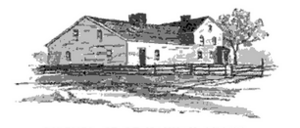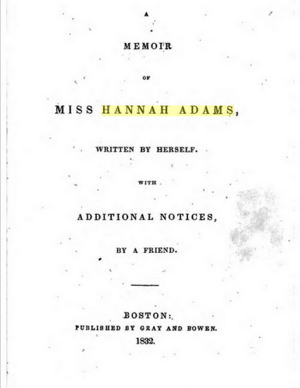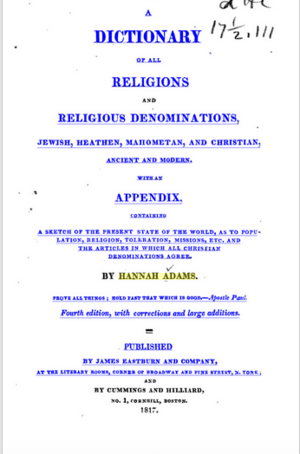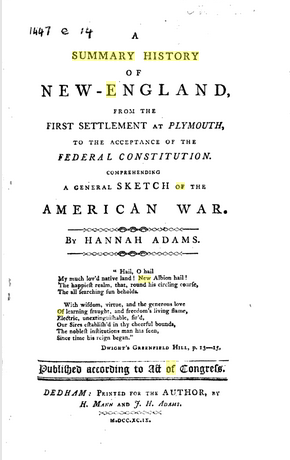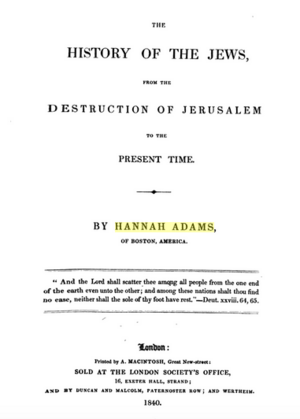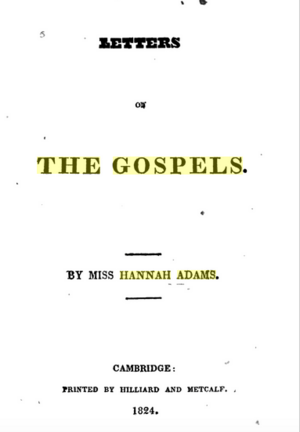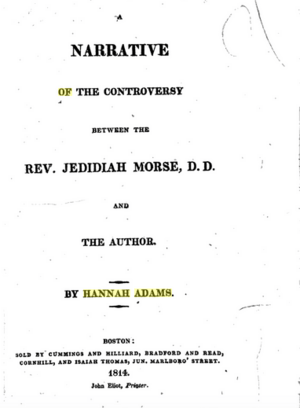Hannah Adams facts for kids
Quick facts for kids
Hannah Adams
|
|
|---|---|
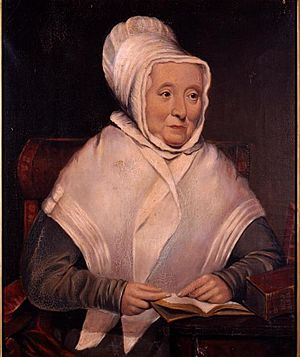
Portrait of Hannah Adams by Francis Alexander, c. 1828
|
|
| Born | October 2, 1755 Medfield, Massachusetts, U.S. |
| Died | December 15, 1831 (aged 76) Brookline, Massachusetts, U.S. |
| Resting place | Mount Auburn Cemetery, Cambridge, Massachusetts, U.S. |
| Occupation | Author |
| Language | English |
| Nationality | American |
| Subject | comparative religion; early United States history |
| Notable works | A View of Religions (1784); A Summary History of New-England (1799) |
| Relatives | John Adams, distant cousin |
| Signature | |
Hannah Adams (born October 2, 1755 – died December 15, 1831) was an American writer. She wrote books about different religions and early American history. Hannah was born in Medfield, Massachusetts and passed away in Brookline. She was the first woman in the United States to earn a living as a professional writer.
Hannah was the second of five children. Her parents were Thomas Adams and Elizabeth Clark. She grew up in a quiet country town. Even though she taught herself much of what she knew, she became a very learned woman. This was rare for women in New England at that time.
Hannah often faced poor health and didn't have much money. She had to work many different jobs to support herself. Despite these challenges, she kept studying and learning. Her father, who went to Harvard College, ran a small store. He sold books and also hosted students who were studying to become ministers. Hannah learned Greek and Latin from these students. Later, she even taught these languages herself.
Her first book, A View of Religions, came out in 1784. A bigger version was published in 1791. The money she earned from this book helped her pay off debts and live more comfortably. In 1799, she published A Summary History of New-England. While working on this book, she strained her eyes reading old papers. She had to hire someone to write down her words for the printers.
Her most detailed book was The History of the Jews. It was reprinted in London in 1818. Hannah also started writing her autobiography, which was published after she died. Later in her life, friends helped her by setting up a small yearly payment. This made her final years more comfortable.
Contents
Hannah's Early Life and Learning
Hannah Adams came from a family that had been important in her hometown for many years. Her family helped found the town. Her grandfather owned a lot of land. Hannah's father, Thomas, was meant to take over the family farm. But he loved books more than farming. So, he opened a shop that sold English books and other goods.
In 1750, her father married Elizabeth Clark. Hannah's mother died when Hannah was only 11 years old. This left five children, and Hannah's older sister, Elizabeth (nicknamed "Betty"), helped care for Hannah and her younger sister.
Hannah was a very shy child and often felt unwell. Because of her delicate health, she didn't go to the local school. Instead, her father taught her reading, writing, and math at home. She loved poetry and memorized many poems by her favorite writers like Milton. She also enjoyed history and biographies, finding them full of interesting stories.
Hannah also liked novels, but she later said they gave her a false idea of what the real world was like. She always felt that she missed out on a more complete education when she was young. Still, by the time she was 20, she had read more than most women of her time. She loved learning. When some gentlemen staying at her father's house offered to teach her Latin, Greek, geography, and logic, she eagerly accepted.
A few years after her mother died, her father's business failed. Hannah felt she needed to help support her family. She tried sewing, knitting, and spinning. She earned the most money by weaving bobbin lace. However, after the American Revolutionary War, lace was imported from other countries. This meant she couldn't sell her lace anymore, and she faced financial hardship. During this difficult time, she found a way to earn money by teaching Latin and Greek to three young men. One of her students, Pitt Clarke, later became a pastor for over 40 years. He said that Hannah's teaching helped him get ready for college.
Her father found comfort in books during his difficult times. He loved visiting the Harvard College Library. Once, he even said he would rather be the librarian there than an emperor!
Hannah's Career as a Writer
During the American Revolutionary War, Hannah worked hard to help her family. She sewed, knitted, spun, and wove bobbin lace. Lacemaking brought her the most money. But after the war, imported lace made it hard for her to sell her own. This led to financial problems. Soon after, she started teaching Latin and Greek to three young men. She did such a good job that one of them said her teaching helped him prepare for college.
Hannah's books didn't make her rich, but they brought her fame and many friends. One important friend was the Abbé Grégoire, a French priest, with whom she exchanged many letters. Her excellent writing also earned her the respect of important thinkers in Boston. These included William Smith Shaw and Joseph Stevens Buckminster. These men later started the Anthology Society, which was a group that led to the Boston Athenæum. They became Hannah's lifelong supporters. In 1809, they set up a small yearly payment for her. This helped her avoid poverty. Their support also helped her write History of the Jews (1812).
Hannah Adams was the first professional writer to become a member of the Boston Athenæum. This library still keeps some of her letters, early editions of her books, and a portrait of her. Her autobiography, which was edited by her friend Hannah Farnham Sawyer Lee, was published in Boston in 1832.
Hannah's Main Books
A View of Religions
A View of Religions was first published in 1784. Its original title was very long! The second edition, published in 1791, was simply called A View of Religions. Later, the fourth edition was renamed Dictionary of Religions. This book was Hannah Adams's most important work. In it, she explored many different religions from around the world.
Her book was special because she wrote about each religion from the viewpoint of its followers. She didn't try to make her own beliefs seem better. A View of Religions had three main parts:
- An Alphabetical Compendium of the Various Sects Which Have Appeared from the Beginning of the Christian Era to the Present Day
- A Brief Account of Paganism, Mohammedanism, Judaism, and Deism
- An Account of the Different Religions of the World
Hannah started writing this book because she felt that most writers were unfair when describing different religious groups. She had read a manuscript that talked about some common religious groups and wanted to write something better.
Her first book was published after people promised to buy copies, which was common at the time. She made some money, but not as much as she should have because of a bad deal with the printer. A second, larger edition came out in 1791. This time, she had help from influential friends in Boston. This edition was dedicated to John Adams, who was then the Vice-President. He was the first person to subscribe to the book. Many other important people also supported her work. Her father was very enthusiastic and traveled around the country selling the books. A fourth edition of her first work, with even more information, appeared in 1817. It was called A Dictionary of All Religions and Religious Denominations.
A Summary History of New-England
Hannah's second book, A Summary History of New-England, was published in 1799. She wrote it after working as a country school teacher. In 1801, a third edition of her first book came out, with more added content.
Next, she put together a book of writings from different authors. It was called Truth and Excellence of the Christian Religion. She often worked on her material in Boston bookstores because she couldn't afford to buy or borrow all the books she needed. In 1805, a shorter version of her New England history was published. This led to a disagreement with Rev. Jedidiah Morse, who had written a similar history. Friends like William Shaw helped Hannah during this dispute.
History of the Jews and Letters on the Gospels
Hannah gathered most of the information for her History of the Jews (1812) at the Boston Athenæum. She was allowed to use their library thanks to William Shaw. She also found a friend and helper in Mr. Buckminster, a minister, who let her use his study and library. President John Adams also let her use his library at his home.
While writing this history, Hannah had to braid straw to earn money. But eventually, some kind women in Boston raised money for her. This gave her a small yearly income, making her later years more comfortable.
Her last book, Letters on the Gospels, was written when she was 70 years old. She grew old happily. She would entertain friends who visited her small home by reciting poetry she had learned as a girl.
A Memoir of Miss Hannah Adams
Mrs. Josiah Quincy III, whose husband was the mayor of Boston, asked Hannah to write her autobiography. This short account of her life, less than 50 pages, was published after her death. Hannah hoped it would help her older sister, who had shared her small earnings for many years. The book includes a picture of Hannah from a portrait painted by Chester Harding (painter). This portrait was placed in the Boston Athenæum, which also holds all of Hannah Adams's books.
Hannah's Personal Life
Hannah Adams was a popular guest in New England society. She once stayed for two weeks at the home of her distant cousin, President John Adams. She described herself as a Unitarian Christian. William Shaw and his friends collected money to give Hannah financial support. They also helped her during her disagreement with Rev. Jedidiah Morse in 1804.
Hannah wrote about this help: "During this visit at Boston, I received the unexpected intelligence, that a number of benevolent gentlemen had settled an annuity upon me, to relieve me from the embarrassments I had hitherto suffered. The Hon. Josiah Quincy, Stephen Higginson, Esq. and William Shaw, Esq. were some of its first promoters. This providential interference excited my most lively gratitude to my generous benefactors, and I hope I sensibly felt my deep obligation to the source of all good."
Her friend, Mrs. Lee, who helped with Hannah's memoir, added: "After [Rev. Dr. Joseph Stevens Buckminster] became the Pastor of Brattle Street Church, he, with Mr. Higginson, and Mr. Shaw the active founder of the Athenæum, proposed to Miss Adams, who, from an enfeebled constitution, had begun to grow infirm, to remove to Boston; at the same time procuring for her, through the liberal subscription of a few gentlemen, an annuity for life."
Hannah's birthplace in Medfield is still preserved today. She was buried at Mount Auburn Cemetery in Cambridge, Massachusetts. Her monument says she was the cemetery's "First Tenant," but she was actually the ninth person buried there.
Selected Works by Hannah Adams
- View of Religious Opinions (1784)
- A Summary History of New England (1799)
- Evidences of Christianity (1801)
- The Truth and Excellence of the Christian Religion (1804)
- An Abridgment of the History of New-England: For the Use of Young Persons: Now Introduced into the Principal Schools in this Town (1807)
- History of the Jews (1812)
- Controversy with Dr. Morse (1814) (This book was about a legal disagreement she had with Morse in 1801.)
- A Dictionary of All Religions and Religious Denominations (1817)
- Letters on the Gospels (1824; second edition 1826)
- A Memoir of Miss Hannah Adams (1832; her autobiography)
Images for kids
See also
 In Spanish: Hannah Adams para niños
In Spanish: Hannah Adams para niños


